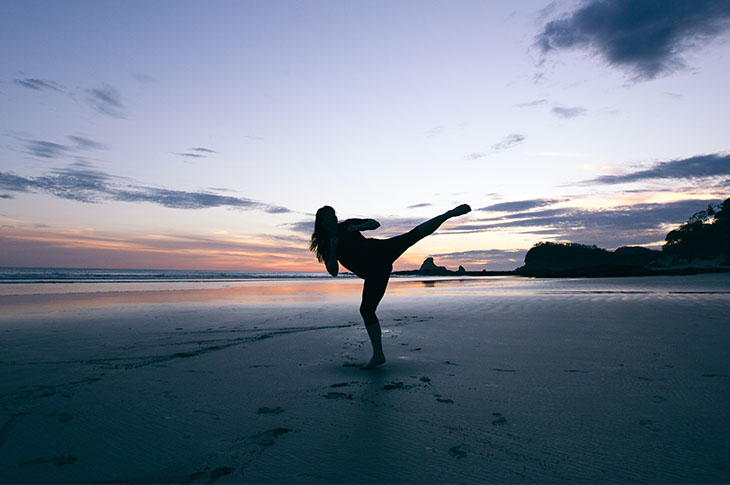It’s been a week of missed deadlines, long commutes, and doom scrolling; there are dishes in the sink, unanswered texts, missed Snapchats, and nothing in the fridge. Mustering up the zen to sit still and meditate isn’t in the cards but you need to figure out how to shake off the stress. Tai chi could help.
Tai chi, a Chinese mindfulness technique with roots in ancient China, involves a series of gentle flowing movements (no sitting still or chanting “OM” required) that has been proven to promote calmness and potentially reduce anxiety. And when the mind relaxes, the body finds flexibility and balance.
What is Tai Chi?
“Tai chi chuan (also called tai chi) is an ancient Chinese practice and a form of exercise that uses similar movements in martial arts. It is done without a partner and is a kind of shadow boxing,” explains Tsao-Lin, an alternative health and Chinese medicine expert.
She adds that while it may appear easy, it requires a great deal of focus, coordinated breathing, and cognitive coordination. This 2021 study shows that tai chi improves neuroplasticity and cognitive flexibility and function.
Similar to yoga, many consider tai chi a moving meditation requiring practice and dedication. Tai chi breaks down into several types or forms, and each of them incorporate different animal movements such as the Crane, Tiger, or Snake.
Who is Tai Chi for?
“From five years to 100 years, anyone can do tai chi because it is a low impact exercise that focuses on balance, flexibility, and breathing,” Tsao-Lin says. It may also reduce stress on your joints and muscles.
The mindfulness technique’s accessibility may attract people to it as well. You don’t need fancy, high-tech equipment or well-furnished environments to practice.
Practice tai chi anywhere—indoors or outdoors—alone. However, Tsao-Lin suggests that you’ll enjoy it most when you do it with others.
If you’ve ever seen people doing tai chi in parks at the crack of dawn, you’ll notice them facing the East. Tsao-Lin explains that “daylight carries more Yang energy, and it is a way to absorb Yang qi into the body.”
She continues by saying this “outside practice supports being in sync with Yin and Yang of nature and circadian rhythms.”
Tai chi is easy to start but takes years of consistency to master. Think of it as a lifelong and life-extending practice.
The Major Benefits of Tai Chi
Over 500 clinical trials and research studies have found tai chi to improve memory, help with pain management, and considerably lower stress. Additional benefits of tai chi include decreased anxiety and depression and higher cognitive function.
If done properly, tai chi can generally improve your health. Some of the benefits include:
Decreased stress, anxiety, and blood pressure. Better mood.Improved movement and balance.Improved muscle reflexes and blood flow.Safe movement.Improved blood oxygen and cognitive function.
Although it needs more research, some existing evidence shows that tai chi can:
Improve your sleep quality.Boost your immune system.Lower blood pressure.Improve joint pain and overall wellness.
How to Perform Tai Chi
Performing tai chi happens in sets that look like a dance routine. With several styles of tai chi, the practice offers both long and short forms, but basic tai chi consists of 24 movements.
Now, it may suit best to learn tai chi from a qualified instructor, especially as a beginner. However, certain books or videos can guide you. Tsao-Lin recommends this YouTube video for people who want to learn a few techniques.
You can find numerous tai chi classes in communities today. To start, find a class near you and reach out to them. Remember that tai chi instructors don’t need to have licenses or attend an A+ program. For certainty in the kind of training you receive, make enquiries about your instructor.
You should expect your instructor to teach you certain positions and breathing techniques. They would teach how to practice the exercise safely due to the risk of injury that may occur if you don’t take proper safety measures and form.
After a couple of classes from your instructor, you should be able to carry the techniques on your own.
You may begin to see some of the benefits of tai chi after you practice for about 12 weeks. However, it won’t do any harm to continue for a longer time and improve your overall wellness.
Tai chi serves to relieve stress among other things. So, don’t overthink the time and place you should do your exercise. Do it when you can and take it easy on yourself. When feeling tense, you can even imagine the movements of tai chi without actually moving—even at work!
The post Reduce Your Stress with Tai Chi, a Chinese Mindfulness Technique appeared first on Fitbit Blog.
